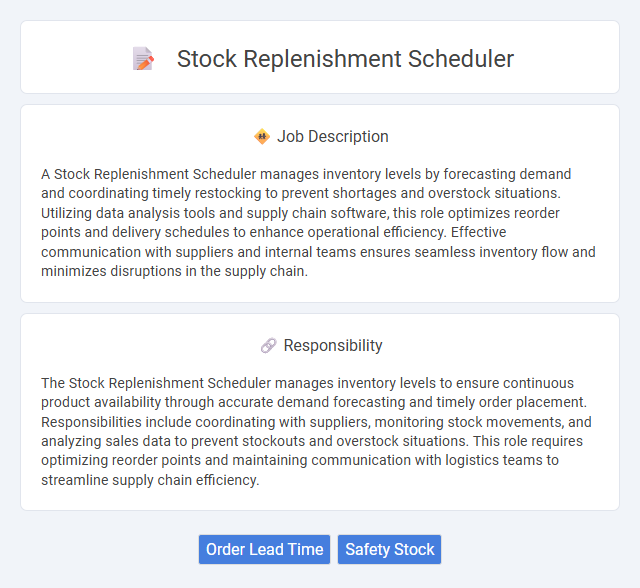
A Stock Replenishment Scheduler manages inventory levels by forecasting demand and coordinating timely restocking to prevent shortages and overstock situations. Utilizing data analysis tools and supply chain software, this role optimizes reorder points and delivery schedules to enhance operational efficiency. Effective communication with suppliers and internal teams ensures seamless inventory flow and minimizes disruptions in the supply chain.
Individuals with strong organizational skills and attention to detail are likely to thrive in a Stock Replenishment Scheduler role. Those comfortable working under pressure and managing inventory data may find this position suitable due to its demand for accuracy and timely decision-making. Candidates who prefer repetitive tasks or struggle with multitasking might face challenges adapting to the dynamic nature of stock scheduling.
Qualification
A Stock Replenishment Scheduler typically requires a background in supply chain management, logistics, or inventory control, with proficiency in ERP systems such as SAP or Oracle. Strong analytical skills and experience in demand forecasting, inventory optimization, and vendor coordination are essential. Excellent communication and problem-solving abilities ensure efficient stock levels and minimize shortages or overstock situations.
Responsibility
The Stock Replenishment Scheduler manages inventory levels to ensure continuous product availability through accurate demand forecasting and timely order placement. Responsibilities include coordinating with suppliers, monitoring stock movements, and analyzing sales data to prevent stockouts and overstock situations. This role requires optimizing reorder points and maintaining communication with logistics teams to streamline supply chain efficiency.
Benefit
The Stock Replenishment Scheduler role likely enhances inventory management efficiency by predicting demand and coordinating timely restocks, which may reduce stockouts and overstock situations. This could improve cash flow and customer satisfaction through consistent product availability. Employing this position might lead to streamlined supply chain operations and lower carrying costs.
Challenge
The Stock Replenishment Scheduler role likely involves managing unpredictable supply chain fluctuations and demand variability that challenge maintaining optimal inventory levels. Navigating delays from suppliers and sudden shifts in sales patterns may frequently complicate timely stock replenishment. Balancing cost-efficiency with service level targets probably requires constant adjustment and effective forecasting to avoid stockouts or overstock situations.
Career Advancement
The Stock Replenishment Scheduler plays a critical role in optimizing inventory levels and ensuring timely product availability, which is essential for operational efficiency in supply chain management. Mastery of advanced inventory forecasting tools and ERP systems can lead to opportunities for promotion into senior supply chain analyst or inventory manager positions. Developing strong analytical skills and cross-functional collaboration experience further enhances career advancement prospects within logistics and demand planning sectors.
Key Terms
Order Lead Time
Order lead time is a critical factor in stock replenishment scheduling, influencing inventory levels and customer satisfaction. Effective schedulers analyze historical order lead times to predict accurate replenishment dates, minimizing stockouts and overstock situations. Leveraging real-time data and supplier performance metrics enhances the precision of lead time estimates, optimizing the entire supply chain process.
Safety Stock
A Stock Replenishment Scheduler manages inventory levels by accurately forecasting demand and coordinating timely restocking to maintain optimal safety stock. This role ensures safety stock buffers are strategically set to prevent stockouts while minimizing excess inventory costs. Effective monitoring and adjustment of safety stock based on sales trends and supply chain variability enhance overall inventory reliability and operational efficiency.
 kuljobs.com
kuljobs.com